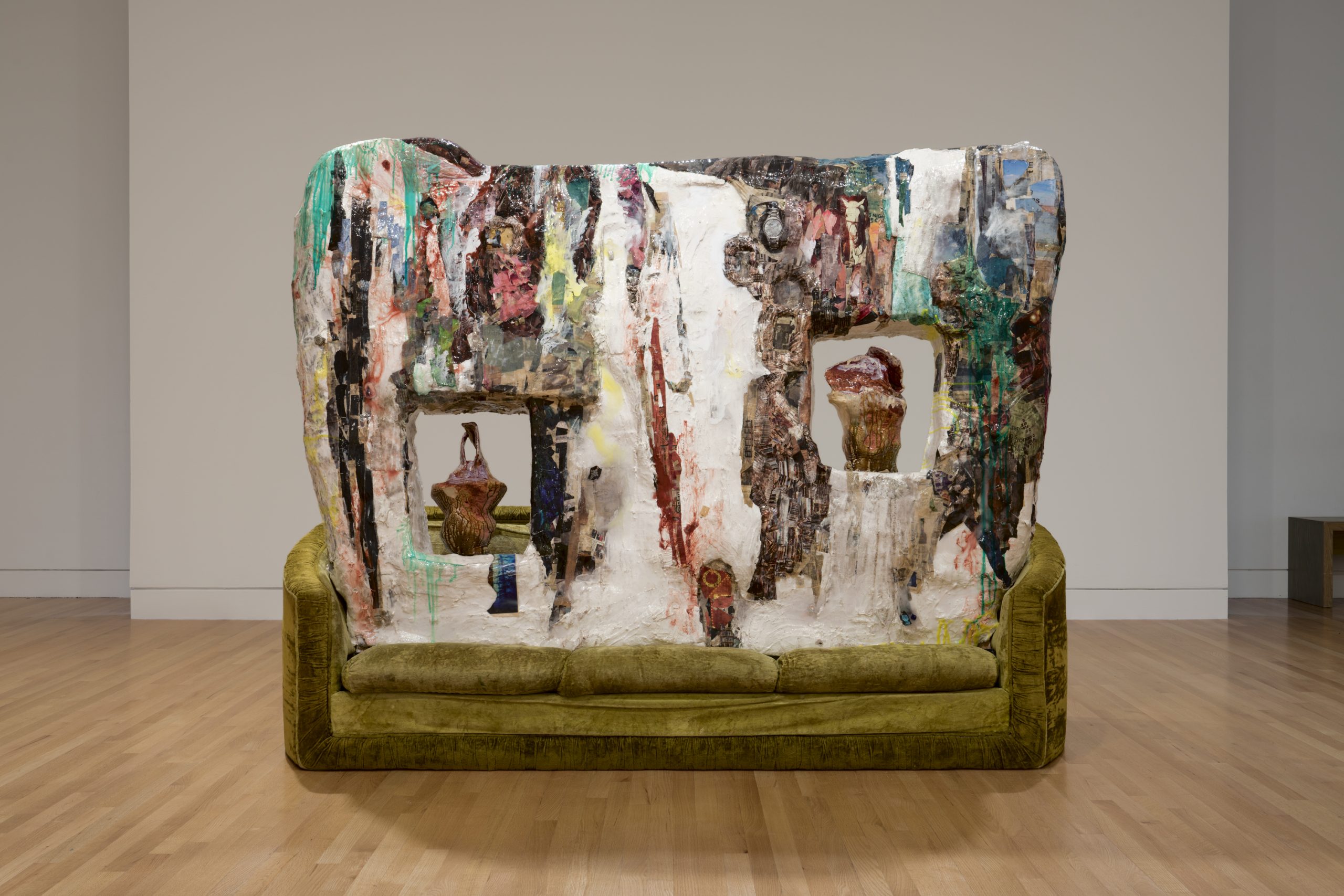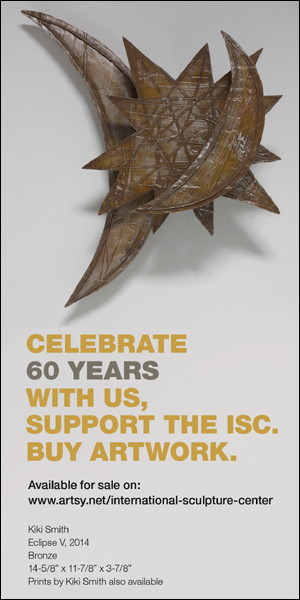Seattle
“Wrecked and Righteous,” Jessica Jackson Hutchins’s 20-year survey (on view through May 5, 2024), brings together an enormous number of works made of everything from clay, glass, and papier-mâché to plastic and fabric. The show could just as easily have been titled “Smashed and Moshed” to reflect the Portland-based artist’s processes of layering, juxtaposing, and jamming together myriad elements in each piece. She also mixes subjects and genres freely, employing figurative surrogates, still-life elements, disused furniture, relief paintings, needlepoints, and vessels. How can one artist apply so many strange and seemingly wayward approaches to such a huge array of materials? As Walt Whitman asked and answered, “Do I contradict myself? / Very well then I contradict myself, / (I am large. I contain multitudes).” Hutchins’s sensibility is just as wide-ranging and nonhierarchical: paintings are no more privileged than pots; junk store sofas are no less respected than pedestal sculptures; craft, in practice, is equal to art—all wrapped up and held together by an expansive, overflowing imagination.
It’s almost too much to take in. There are nearly 80 works on view, the majority consisting of abstract ceramic or pulped paper sculptures mounted on shelves or low plinths. This aspect of Hutchins’s work alone could merit an exhibition. Here, these works provide a starting point to examine her evolving aesthetic, which started during graduate school at the Art Institute of Chicago with small, stacked try-outs of slabs, shapes, and glazes already perfected by other artists. For example, wall-mounted, cut-up found cardboard collages shout out to Robert Rauschenberg (Wounds of Compassion, 2006), and paper-pulp-bound beer bottles recall Jasper Johns (Brooklyn Bottles, 2000). Among the pottery, old and new, giants like Peter Voulkos (Love As It Is, 2021) and Ken Price (A Ramble, 2008, and Star topper, 1999) wink at us alongside echoes of New York ceramists such as Kathy Butterly (Hot Mustard Tears, 2021) and Michael Lucero (Mountain Home, 2014). The best of Hutchins’s ceramic works bring a more individual style to the medium. Mostly vertical, built-up stacks (10 to 50 inches high) mix cast glass in some cases (Jaywalker, 2022) and, in others, use glaze as a drenching surface to unify ambiguous but appealing conglomerations of slabs (Blue-green Landscape, 2014).
Perhaps it’s me, but I prefer these tighter-focus, unitary works over some of the “everything-but-the-kitchen-sink” assemblage sculptures. Though, to be fair, the kitchen sink is the only thing missing in these large-scale groupings, which can be impressively all over the place. A smashed, worn-out sofa dramatically supports a teetering, seemingly perilous plaster wall in Wishlist (2015). A similar approach is whimsically repeated in Wild Core (2019), with its upside-down mid-century modern fiberglass chair, while the upholstered armchair fabric in The Star (2020) cruelly parodies Arts and Crafts wallpaper by William Morris. In the defiantly downbeat Lascaux Reprise (2012/2018), the chair has had its front legs amputated; frightening snakes of leather and clay slither over the wing back, lending an expressionistic power that makes it simultaneously attractive and repulsive. Rauschenberg and Johns return as patron saints of Third Eye and Seascape (both 2015), wall-relief paintings with attached folding chairs. Two other assemblages, Rope Stanza (2013) and Berliner Haus (2012), recall the late Sam Gilliam, who draped painted fabrics over concealed freestanding struts to colorful effect. In Hutchins’s hands, a ladder supports darker cloths, with ominous and threatening implications, all seemingly on the verge of collapse.
Beyond the art historical references, Hutchins’s work involves so many Americana-related themes—building, sewing, lounging, eating, trashing—that it’s hard to keep track of where and how she has traveled. Curator Amanda Donnan deliberately avoids any chronological layout and has replaced conventional wall labels with Hutchins’s own statements about her work: “They relate to motherhood…where your body is the food…It wasn’t consciously in my mind, but you can’t argue with it”; “The intention is that they are convivial.” In lieu of a catalogue, the artist is left to her own interpretive devices.
Out of all this richness, My Friend the Poet (2019), a beheaded pink torso without arms and feet poised to slide off a flimsy black chair, emerged as my favorite work. The precarity of the poet’s life and the naked delicacy of his or her expressive vision are perfectly captured, all without a single explanatory note or cue.




